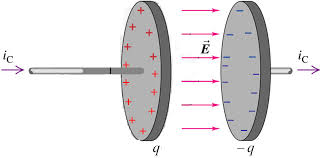



"A changing magnetic field (
) gives rise to an electric field (
)"
For a more complete correspondence between E and B we would expect a term added to the right hand side of Ampere's Law which indicates,
"A changing electric field (
) gives rise to a magnetic field (
)"

Inconsistency in Ampere's Law

where we have made use of the general relationship between current and current density,
Note that the surface over which the flux of J is evaluated, S, can be any open surface bounded by the closed Amperian loop C.
In the figure at right, showing a schematic of a parallel plate capacitor being charged, 4 possible surfaces are shown bounded by a single Amperian loop. For each of these surfaces the flux of J must give the same current. As indicated, surfaces 1, 2 and 4 are "pierced" by the current I. However, as can be seen, no current passes through surface 3.
What to do about this inconsistency ?
Fixing Ampere's Law

Therefore, if we define
as the displacement current, by writing
we can ensure this inconsistency in Ampere's Law is removed.


Parallel Plate Capacitor
 For a parallel
plate capacitor we have,
For a parallel
plate capacitor we have,
where,
therefore,
So that the displacement current id is equal to the conduction current bringing charge to the plates, i.
The presence of the displacement current would be signaled by detection of its associated magnetic field. Assuming only a displacement current we can write Ampere's Law,

so that,
where A is a representative cross section and l a representative length.
Thus, unless dE/dt and A/l are very large, B will be very small. In Faraday's time it was technologically impossible to vary the E field fast enough to obtain a measurable B.
Famous Physicists at a party : Everyone gravitated toward Newton, but he just kept moving around at a constant velocity and showed no reaction.
Dr. C. L. Davis
Physics Department
University of Louisville
email: c.l.davis@louisville.edu
